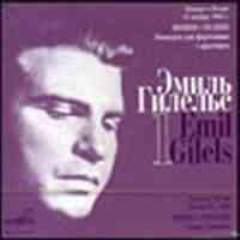Francis Poulenc - Concert Champêtre for piano & orch. (Gilels) [1962]
Francis Poulenc - Concert Champêtre for piano & orch. (Gilels) [1962]

1. Adagio – Allegro molto 2. Andante 3. Finale. Presto tres gai Emil Gilels, piano Moscow Philharmonic Orchestra Kiril Kondrashin - conductor
Having already established himself as a musical rebel by the age of 18, Poulenc paid no homage to the Germanic tradition still prevalent in French music in his early years but instead crafted clever, unique works which remind some listeners of a sort of French Prokofiev. A mere ten years later, Poulenc, in response to a personal suggestion from the great harpsichordist Wanda Landowska, began composing a rustic concerto for harpsichord and orchestra. It turned out not only was this his first true work in the concerto form, it was, except for his early ballet Les Biches, his first large-scale orchestral work. Because Landowska performed on a specially made, modern, and more powerful harpsichord, the work sets soloist against orchestra on a grand scale. In fact, the orchestra is a large one with full brass and percussion sections and it is only Poulenc's skillful scoring which preserves the textural balance. Also -- because the piece was created with the great Landowska in mind -- it is difficult in the extreme. The result of all this is a fiery three-movement work which sandwiches turns of Baroque-like ornamentalism in between twentieth century riffs to marvelous effect. The work is in fact a delightful study in contrasts. Passages in major and minor modes alternate and the delicate texture of the harpsichord splashes across great, slashing brass chords and amid the thunder of percussion. Even the setting and inspiration for the piece are somewhat contradictory: A self proclaimed city dweller, Poulenc's idea of a rustic setting included mostly the outskirts and near environs of Paris, and the military flourishes and fanfares in the outer movements seem to be an allusion to a French army camp situated near Landowska's forest retreat. The first movement, a sprawling Allegro molto, opens with tootling in the woodwinds and a fanfare in the horns. The harpsichord provides a plaintive introduction and then launches into a jaunty main theme. During the course of this, it fends off thunder from the tympani and more fanfares and even some marching from the brass. Eventually the solo instrument once again gently reasserts itself, restates a minor variant of the main theme, this time at half speed, and after enduring yet another fanfare from the horns, repeats the theme in its original form and ends the movement. The Andante begins simply enough with a soft major melody from the strings and after a transitional passage from the harpsichord, this melody appears twice more with the harpsichord soloist acting only as accompanist. The solo instrument opens the finale by itself with a brisk march and maintains control throughout, stepping aside only to allow punctuation from the percussion and a few more brass fanfares. After the recapitulation, the harpsichord turns to a quiet coda and ends the piece, not with a crash but more like one turning out the light and leaving the room. While not among Poulenc's most mature works, the concerto is top-drawer and satisfying in every respect. ---Michael Morrison, Rovi
download: uploaded yandex 4shared mediafire solidfiles mega filecloudio nornar ziddu
Zmieniony (Wtorek, 18 Marzec 2014 15:16)








